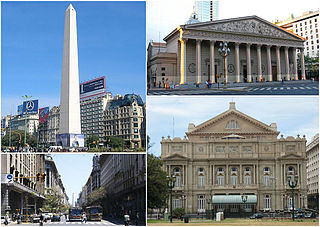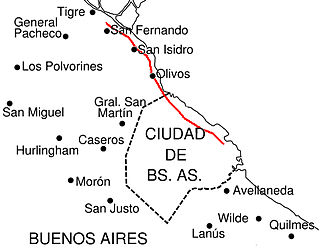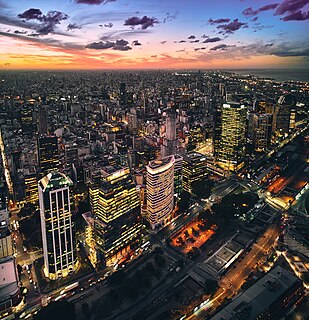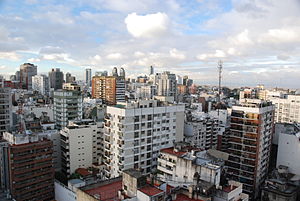
Belgrano is a northern and leafy barrio or neighborhood of Buenos Aires, Argentina.

Balvanera is a barrio or neighborhood of Buenos Aires, Argentina.

Palermo is a barrio or neighborhood of Buenos Aires, Argentina. It is located in the north of the city, near the Rio de la Plata.

Recoleta is a barrio or neighborhood of Buenos Aires, Argentina, located in the northern part of the city, by the Río de la Plata. The area is perhaps best known to be the home of the distinguished Recoleta Cemetery. It is a traditional upper-class and conservative neighborhood, with some of the priciest real estate in the city.

Buenos Aires, autonomous city and capital of Argentina, is composed of forty-eight neighborhoods. Since 2008, the city is also legally divided into communes, each one including one or more barrios. Among the most visited and populated barrios are Palermo, Recoleta, Puerto Madero, Belgrano, San Telmo, La Boca, Monserrat and Caballito. Sectors of the city are also traditionally known as neighborhoods by the inhabitants of Buenos Aires, but not officially by the authorities of the city; some examples include Chinatown, Barrio Norte and the Microcentro.

San Nicolás is one of the neighbourhoods of Buenos Aires, Argentina, sharing most of the city and national government Neighborhood of Buenos Aires with neighboring Montserrat and home to much of the financial sector. It's referred usually as El Centro, and the part east of the 9 de Julio Avenue is known as Microcentro.

Retiro is a barrio or neighborhood in Buenos Aires, Argentina. Located in the northeast end of the city, Retiro is bordered on the south by the Puerto Madero and San Nicolás, and on the west by the Recoleta.

Chacarita is a barrio or neighborhood in the north-central part of Buenos Aires, Argentina. Located between Colegiales, Palermo, Villa Crespo, La Paternal and Villa Ortúzar, this is a quiet neighbourhood with tree-lined streets, a combination of vintage rowhouses and apartment buildings. Locally, it's probably best known for the 95 hectare Chacarita Cemetery.

Buenos Aires is in the midst of a tourism boom, according to the World Travel & Tourism Council, which reveals strong growth for Argentina Travel and Tourism in 2007 and in coming years, and the prestigious travel and tourism publication; Travel + Leisure, a monthly magazine, travelers voted Buenos Aires the second most desirable city to visit after Florence, Italy. Buenos Aires, regarded as the “Paris of South America”, offers elegant architecture, exquisite cuisine, a legendary nightlife, and fashionable shopping. Argentina has become famous for its rich European flavor.

Coronel Díaz Avenue is an avenue that marks the limit between the Palermo and Recoleta neighborhoods in Buenos Aires, Argentina, and extends northbound, parallel Pueyrredón Avenue. It starts on Soler Street and ends on Castex Street, passing along Las Heras Park and the nearby Alto Palermo Shopping Center.

Avenida del Libertador is one of the principal thoroughfares in Buenos Aires, Argentina, and in points north, extending 25 km (16 mi) from the Retiro District of Buenos Aires to the northern suburb of San Fernando.

Avenida Santa Fe is one of the principal thoroughfares in Buenos Aires, Argentina. The artery is essential to the imaginary axis of Barrio Norte in Buenos Aires, comprising the areas influenced by the route of the avenue through Retiro, Recoleta and Palermo neighborhoods, it is considered one of the main shopping and strolling areas of the city, its many boutiques range from elegant to edgy, which has led it to be dubbed the 'Avenue of Fashion'. Upscale Alto Palermo, at Avenida Coronel Díaz, is one of the city's best-known vertical malls. Avenida Santa Fe is also an attraction for its architecture, strongly reminiscent of Paris. Its name pays homage to the eponymous province in Argentina.

Avenida Figueroa Alcorta is a major thoroughfare in Buenos Aires, Argentina, with a length of over 7 km (4.3 mi) along the city's northside.

Córdoba Avenue is one of the principal thoroughfares in Buenos Aires, Argentina.

Callao Avenue is one of the principal thoroughfares in Buenos Aires, Argentina.

The Buenos Aires Central Business District is the main commercial centre of Buenos Aires, Argentina, though not an official city ward. While the barrios of Puerto Madero and Retiro house important business complexes and modern high-rise architecture, the area traditionally known as Microcentro is located within San Nicolás and Monserrat, roughly coinciding with the area around the historic center of the Plaza de Mayo. The Microcentro has a wide concentration of offices, service companies and banks, and a large circulation of pedestrians on working days. Another name given to this unofficial barrio is La City, which refers more precisely to an even smaller sector within the Microcentro, where almost all the banking headquarters of the country are concentrated.

Plaza Italia is a small park in the city of Buenos Aires in the barrio of Palermo on the confluence of Santa Fe Avenue and Avenida Sarmiento. Next to the plaza are the main entrances to the Zoo and the Botanical Gardens, and the la Rural Expo Center. The area is very busy with traffic, as it is a public transportation hub for the city.

Avenida Pueyrredón is an avenue that runs through Recoleta and Balvanera neighborhoods of Buenos Aires, Argentina, and goes from southwest to northeast, parallel Avenida 9 de Julio. It starts at Avenida Rivadavia, and ends at Avenida Figueroa Alcorta.

Avenida Juan B. Justo is an avenue that runs through Palermo and Recoleta neighborhoods of Buenos Aires, Argentina, and goes from southwest to northeast, parallel Pueyrredón avenue. It starts at Santa Fe avenue, and ends at Avenida General Paz.

Córdoba Station is a station on Line H of the Buenos Aires Underground, opened in 2015. It is located in the junction of Córdoba and Pueyrredón Avenues, in the limit with Balvanera and Recoleta neighborhoods. It is near to the University of Buenos Aires faculties of Economics, Pharmacy and Medicine. The station was opened on 18 December 2015 as part of the extension of the line from Corrientes to Las Heras.






















